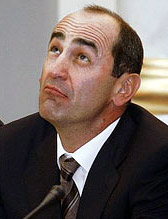The year is coming to an end. Let’s take a look back at the year’s economic achievements of 2005. According to the Statistical Services of Armenia, we end the year with two digit economic rise once again. In the first ten months, the GDP has been estimated to be 1,700 billion drams in market prices. There is a 12.2% economic growth. However, the real economic growth is 8% if we take into consideration the GDP deflator (which shows the relation between the GDP calculated by the prices of this year with those of last year). Let’s mention the fact that the rise in GDP highly depends on the high level of construction. According to official data, growth in number of constructions has been estimated to be 32.6%. Industrial production has grown by 6.1% and agriculture has risen by 10.4%. If any other normal country had these kinds of marks, then we could say that the standard of living has gone up; especially if we take into consideration the fact that the dram has been evaluated and inflation has been low. But is it really so? First, let’s draw our attention to the exchange rates. Everyone is used to seeing the “exchange rate laundering” going through some maneuvers and that happened throughout the year. The rate of the dram went up and down in one day. Logically, if the national dram is evaluated, then the people must get profit because the prices of imported products in drams must go down. However, as always, laws on economy and logic do not work for us and the prices of drams go up parallel to the import of products. This can only mean one thing: large importers made a lot of profit. There is one more important thing. It is no secret that a large part of the population receives its income from the money transfers sent from abroad. According to president of the Central Bank T. Sargsyan, the amount of money transfers this year surpasses 1 billion dollars. In accordance with the data provided by the National Statistical Service of Armenia, the financial incomes of the population during the first ten months of 2005 have been estimated to be 1,102,960.2 million drams; basically, 2 billion 450 million U.S. dollars. Only the money transfers from abroad, which are transferred in exchange rates (primarily in U.S. dollars), form a large part of the incomes. What does this mean? Whereas the people receiving incomes in drams do not get profit from the devaluation of the dollar (as stated above), the people getting profit from the dollar income are not so lucky. So, we are more used to saying “the price of the dollar went down” rather than “the dram is evaluated”.
Armenia had a total rise in foreign trade-both imports and exports. However, there are many negative sides to the balance of trade. The amount during the months from January-October was 445.6 million U.S. dollars. Exports made up 766.4 million dollars compared to the 574.5 million last year. Growth made up 33.4%,however, it would be wrong to say that levels of export have risen by 33.4% because that growth not only depends on growth in production, but also on the growth in prices of products internationally (in particular metals).
It is absurd to talk about the marks for each field of economy, especially since those marks are preliminary. However, there is one mark that must be talked about. We are talking about the Consumer Price Index (CPI), or in other words, sharp rise.
There is a concept in economics-“efect khrapovika” (one-way effect). “Khrapovik” (one way) is a mechanism which functions in one direction. This term is used when we refer to prices with the sense that the prices of some products and services may go down, however, they are not reduced as a whole. Even in the most developed countries, a 3% sharp rise in products is a normal thing. If the mark is very small, then that will be considered abnormal.
It turns out that we exceed other countries not only with our incredible economic rise, but also with our marks. So, compared to last year, as of October 2005, our CPI made up 100.8; basically, it made up 0.8%. The mark of October 2005 made up 99.6% compared to October of last year. We have a negative sharp rise-prices have gone down by 1.4%. As president of the Central Bank T. Sargsyan stated yesterday, it is hard to believe that, however, the calculations show that it really is like that. In general, when it comes to numbers, we kind of get mixed up. The 1700 year old Christian people do not really believe in numbers, whether that be 1.5 million, 12% or minus 1.4%.
According to the data given by the Statistical Services, food prices have gone down and the CPI mark is based on that. Prices have gone up for the following: cultural products and services (4.1%), transportation and communications (4.0%), household products (2.4%), rent, heating and electricity (2.3%).
This is the whole picture for the first ten months which will rarely change until the end of the year. If you step back from reality for a moment, you can look at this and say that living standards have gone up. At least this is what the official statistics say and gives the people these data as presents for New Years’.
As to which gift is the real gift for the people-the 12.2% economic rise, the negative sharp rise, or the increase in telephone prices which is in effect (only by 1 dram, but really 25%), the future inevitable increase in gas heating prices and the future increase in water prices, that is not for us to decide.

